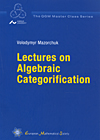- About MAA
- Membership
- MAA Publications
- Periodicals
- Blogs
- MAA Book Series
- MAA Press (an imprint of the AMS)
- MAA Notes
- MAA Reviews
- Mathematical Communication
- Information for Libraries
- Author Resources
- Advertise with MAA
- Meetings
- Competitions
- Programs
- Communities
- MAA Sections
- SIGMAA
- MAA Connect
- Students
- MAA Awards
- Awards Booklets
- Writing Awards
- Teaching Awards
- Service Awards
- Research Awards
- Lecture Awards
- Putnam Competition Individual and Team Winners
- D. E. Shaw Group AMC 8 Awards & Certificates
- Maryam Mirzakhani AMC 10 A Awards & Certificates
- Two Sigma AMC 10 B Awards & Certificates
- Jane Street AMC 12 A Awards & Certificates
- Akamai AMC 12 B Awards & Certificates
- High School Teachers
- News
You are here
Lectures on Algebraic Categorification

Publisher:
European Mathematical Society
Publication Date:
2012
Number of Pages:
119
Format:
Paperback
Series:
The QGM Master Class Series
Price:
36.00
ISBN:
9783037191088
Category:
Monograph
[Reviewed by , on ]
Michael Berg
06/29/2012
It’s a brave new world. I often feel these days that ways of looking at things, even mathematical ones, are constantly in a state of flux if not revolution. Maybe it’s my age talking: when I was younger I thought that such things as Grothendieck’s radical way of doing algebraic geometry, embedding it in an avant garde form of homological algebra (and then some), or even incursions of methods from algebraic topology and differential geometry into number theory (such as the role played by compact Riemann surfaces in the theory of elliptic modular forms), were the gold standard for taking a high-flying bird’s eye view of the mathematical landscape. However, with some developments of the last two decades before our eyes, it now looks like we’re flying even higher.
The book under review is a case in point. I guess that in some ways it’s not all that much of a departure after all, in that as far as categorification goes there are traces of a precedent discernible in, e.g., Grothendieck’s work, but it’s still something a bit unusual: “The term ‘categorification’ was introduced by Louis Crane in 1995 and refers to the process of replacing set-theoretic notions by the corresponding category-theoretic analogues,” according to the book’s back-cover. And it is certainly a popular practice in many quarters these days; see, for instance, the article, http://arxiv.org/abs/math/9802029, coauthored by John Baez and James Dolan. This article’s abstract in fact tells us what the thrust of the matter is: “Categorification is the process of finding category-theoretic analogs of set-theoretic concepts by replacing sets with categories, functions with functors, and equations between functions by natural isomorphisms between functors, which in turn should satisfy certain equations of their own, called ‘coherence laws’…” So that’s what behind the book under review.
And this book is actually closely connected to a collection of fifteen lectures, fourteen of which are available in tandem on a website at Aarhus University: http://qgm.au.dk/video/categ/ — again, it’s a brave new world! It’s really a marvelous experience to be able to attend a lecture series in cyberspace and have in your hands the lecture notes + course text (including a sixteenth chapter titled “exercises”): can there be a better pedagogical experience?
The book is laid out in four parts (with some shuffling), going from “Basics” to “Category O,” then to Sn- categorification and finally to the categorification of the Lie algebra sl2. The material is quite sophisticated in that a lot of background is required on the part of the audience: the lectures themselves were given in what was advertised as a “Master Class” at Aarhus. Indeed, we learn that
[the e]mphasis is on definitions, examples and formulations of … results. Most proofs are either briefly outlined or omitted. However, complete proofs can be found by tracking down references. It is assumed that the reader is familiar with the basics of category theory, representation theory, topology and Lie algebra.
This is pretty much non-negotiable — for instance, Hecke algebras and Kazhdan-Lusztig polynomials occur on p.50 and Koszul duality on p.70 — so be prepared.
Clearly categorification is a fascinating business, and for any one with the required disposition and preparation, this multimedia experience is rightly irresistible.
Michael Berg is Professor of Mathematics at Loyola Marymount University in Los Angeles, CA.
- Basics: decategorification and categorification
- Basics: from categorification of linear maps to $2$-categories
- Basics: $2$-representations of finitary $2$-categories
- Category $\mathcal{O}$: definitions
- Category $\mathcal{O}$: projective and shuffling functors
- Category $\mathcal{O}$: twisting and completion
- Category $\mathcal{O}$: grading and combinatorics
- $\mathbb{S}_n$-categorification: Soergel bimodules, cells and Specht modules
- $\mathbb{S}_n$-categorification: (induced) cell modules
- Category $\mathcal{O}$: Koszul duality
- $\mathfrak{sl}_2$-categorification: simple finite-dimensional modules
- Application: categorification of the Jones polynomial
- $\mathfrak{sl}_2$-categorification of Chuang and Rouquier
- Application: blocks of $\mathbb{F}[\mathbb{S}_n]$ and Broué's conjecture
- Applications of $\mathbb{S}_n$-categorifications
- Exercises
- Bibliography
- Index
- Log in to post comments




